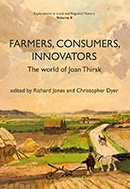RHN 73/2016 | Publication
Richard Jones, Christopher Dyer (eds.), Farmers, Consumers, Innovators. The world of Joan Thirsk (Explorations in local and regional history, Vol. 8), Hatfield/Hertfordshire: UH Press 2016
Joan Thirsk was the leading English agrarian historian of the late 20th century. Perhaps best known for her research into regional farming, she also wrote much about rural industry, changing tastes and fashions, and innovations in the rural economy. This book is based on a conference held in her honour (following her death in 2013) that was intended not to look back but rather to identify Joan Thirsk’s relevance for historians now, and to present new work that has been influenced and inspired by her. Some of the contributors are scholars who knew Joan, and as students were taught and supervised by her; others are younger people who know of her ideas from her publications.
Joan Thirsk’s agrarian research revealed rural England to be a rich mosaic of distinct farming regions, each with its own way of working the land. It had been supposed that, before the Agricultural Revolution, peasants were dull conservatives who resisted innovation and had to be forced into modernity. Thirsk’s work, by contrast, highlighted farmers’ ability to respond to the demands of consumers and the capacity of industries to satisfy changing fashions, such as the vogue for knitted stockings. Her writings were informed by a sympathy for country people, which enabled her to appreciate their wisdom and common sense.
The contributors to this book have been inspired by Joan Thirsk’s revelation of a lively, varied and developing rural scene, and pursue themes that extend her pioneering work in new ways. Their chapters on regional differences, farming methods, conflicts over the use of land, shopping opportunities, fashion and consumption resonate with each other and present fresh insights into a world that was undergoing transformation well before the Agricultural Revolution.
Source: www.herts.ac.uk
